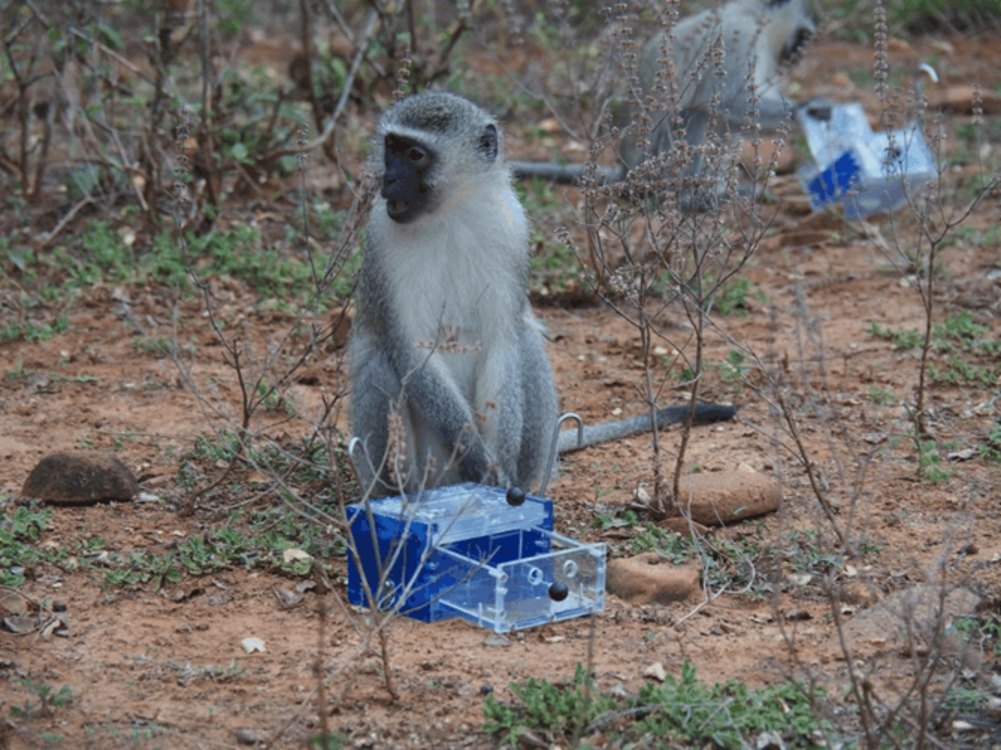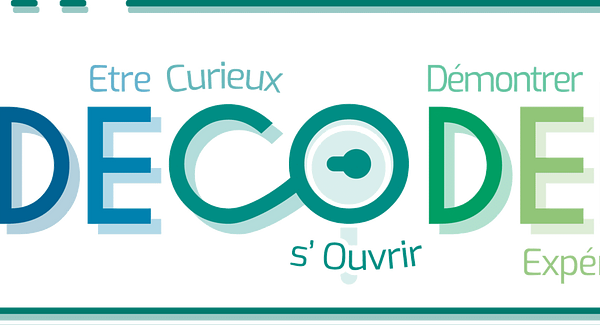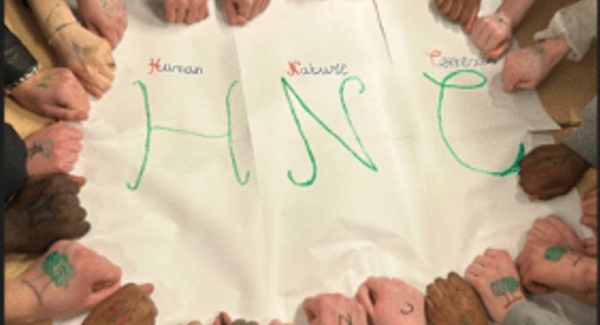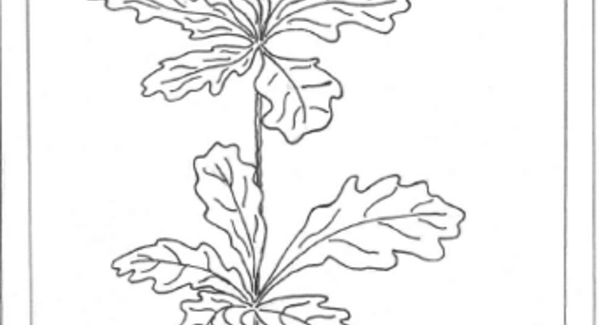Monkeys learn from high status individuals!
Publié par Journal Décoder, le 13 juin 2022 2.4k
Charlotte Canteloup1 (chercheuse) et la classe de DNL du collège Jean Racine (la liste des élèves est mentionnée en fin d’article) de Fanny Bitauld2
Institutions: 1 Department of Ecology & Evolution, University of Lausanne, Switzerland
2 Collège Jean Racine, 24 Rue Paul Doucet, 02400 Château-Thierry
Abstract
Social learning is considered as the basis for traditions and culture. The rules underlying how a new behaviour spread in a whole group are still poorly known. With the aim to fill this gap, we conducted an open diffusion experiment with no trained model in which eight identical puzzle boxes that could be open through two different opening techniques have been simultaneously proposed within two wild groups of vervet monkeys (Chlorocebus pygerythrus) in Kwazulu-Natal, South Africa. The aim of this study was to test whether box opening techniques were socially transmitted between individuals and from whom monkeys learnt. Were related individuals, females, older individuals, or high-ranking individuals considered as preferred models? The data were analysed using a pioneering modelling approach named Network Based Diffusion Analysis (NBDA) that consider the order with which individuals acquired the opening techniques. We found that individuals preferentially used techniques displayed by the individuals they watched evidencing that box opening techniques were socially transmitted and that they learnt from higher-ranked individuals. This study had the interest to combine field experiment and powerful Social Network Analyses that can shed new light on the evolution of culture.
I. Introduction
Social learning, defined as learning facilitated by observation of, or interaction with another individual (Heyes, 1994), has aroused particular interest as it is a likely mechanism for how cultural traditions are established and maintained. Social learning is widespread in the animal kingdom with examples ranging from female fruit flies that choose their sexual mate after observing the preference of other females (Danchin et al. 2018) to humpback whales that socially learn a new hunting technique called ‘lobtail feeding’ (Allen et al. 2013), passing by new tool use in chimpanzees (Hobaiter et al. 2014) or new foraging techniques in great tits (Aplin et al. 2015). The study of social learning has been enriched by the integration of the study of social relationships via social networks and recent advances in statistical methodologies that allow researchers to track the diffusion of behavioural innovations across social networks.
Social learning strategies refer to learning biases that can be based on behaviours’ content or context (Kendal et al. 2018). Theoretical models predict that organisms would copy particular traits performed by specific individuals under suitable circumstances (Rogers, 1988).
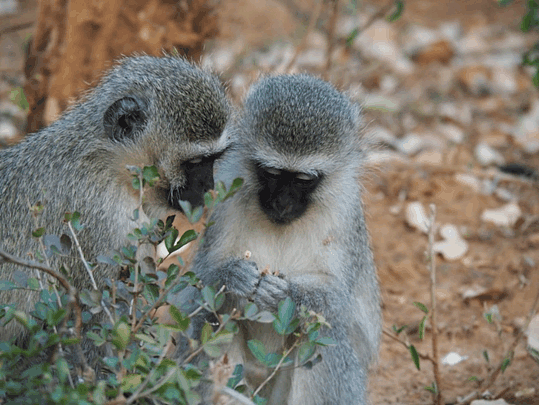

Several primates’ species have been shown to be selective in copying specific individuals or behaviours, revealing surprising parallels with the social learning of humans. Captive chimpanzees displayed bias towards copying older, high-ranking individuals (Horner et al. 2010) and the majority of individuals (Haun et al. 2012). Field experiments reported multiple social learning strategies in wild vervet monkeys in which infants processed food in the same way as their mother (van de Waal et al. 2012; 2014), high-ranking females – the philopatric sex – were preferred as models than high-ranking males (van de Waal et al. 2010) and dispersing males conformed to the local foraging norm, abandoning their native preference (van de Waal et al. 2013). Capuchins have been found to copy older individuals with more successful fruit opening techniques (Barrett et al. 2017) while in vervet monkeys, males, but not females, were more likely to copy the male model receiving a higher payoff in a two-action learning task (Bono et al. 2018). Despite a great number of studies, some results, inconsistent with previous ones, have been reported (Vale et al. 2017) and interpretations in terms of social learning strategies have been sometimes considered as premature (Barrett, 2019). Moreover, most experiments were one-to-one diffusion experiments, using only one trained demonstrator leading these social learning strategies mostly tested separately. Findings suggest that different social characteristics strongly, and may jointly, influence social learning patterns but in an indistinct extent that still needs to be enlightened.
The present study focused on model biases in a nonhuman primate species: vervet monkeys (Chlorocebus pygerythrus) (Figure 1; Table 1) and is articulated around two main questions: i) Do monkeys socially learn a novel foraging technique? ii) If yes, what are the social learning strategies implied in such transmission? In other words, are related individuals, females, older individuals or high-ranking individuals considered as preferred models? We hypothesized that particular individuals would be more influential demonstrators for some individuals than others. Many previous studies looked for the evidence of a single social learning strategy and did not evaluate whether other and multiple potential alternative explanations were plausible. We aimed here to challenge the notion of a single best strategy or a strategy associating several biases by using an open diffusion experiment with no trained models. For this, we offered to the monkeys simultaneously eight ‘two-action’ designs consisting of puzzle boxes named artificial fruits that could be opened in two different ways to gain access to a small apple slice: a drawer in the front could be pulled and a door on the top of the box could be lifted (Fig. 2). The monkeys were free to interact with the boxes and to discover by themselves how to open the boxes using one of the two opening techniques.
| Scientific name | Chlorocebus pygerythrus |
| Size | From 40 to 50cm long (+tail from 30 to 50cm) |
| Weight | Up to 3,5kg (female) and 4,5kg (male) |
| Longevity | Until 30 years |
| Home | East and South Africa. In savannahs and wooded areas but do not like deserts and dense forests. |
| Dietary diet | Omnivorous. Also eat fruits, leaves, seeds, flowers, insects, worms and other small animals. |
| Lifestyle | They live in groups of up to 50 individuals, they are mainly terrestrial, and they sleep in trees for the night. |
II. Methods
Two groups of wild vervet monkeys (Chlorocebus pygerythus) took part in the study within the Inkawu Vervet Project in KwaZulu-Natal, South Africa. One group was called Noha and was composed of 28 individuals (two adult males; 6 adult females; 12 juveniles males; 8 juveniles females). The other group was called Kubu and was composed of 12 individuals (1 adult male; 6 adult females; 5 juveniles males).
The experimental apparatus consisted in a two-action design: a transparent plastic box with the back and adjacent sides painted in blue that could be opened in two different ways to gain access to a thin slice of apple inside: a lid on the top of the box could be lifted and a drawer in the front could be pulled (Fig. 2). Eight identical puzzle boxes were simultaneously displayed to the monkeys to prevent monopolization of a single box by dominant monkeys. The monkeys were free to interact with the boxes and to discover by themselves how to open the boxes using one of the two opening techniques. We video recorded the experiments and we registered who manipulated the boxes, which technique was used and who was observing whom. We ran this experiment for several months until most of the group members had participated to the experiments. The experiment has been repeated 17 times in Noha and 12 times in Kubu. We analysed the data using a powerful statistical method named Network Based Diffusion Analysis (NBDA). NBDA is used to detect and quantify social transmission, but also to identify the typical pathways of social transmission. NBDA considers the order with which individuals in the group acquired a new behavioural trait and tests whether the diffusion is at random or follows specified social networks representing different pathways of learning (Franz & Nunn 2009; Hoppitt, 2017). The underlying hypothesis is that the rate of social transmission between individuals is proportional to the network connection between them; the more two individuals are observing each other, the more opportunities they must learn from each other. We extracted a dynamic observation network from open diffusion experiment data reflecting the number of times each individual observed others performing the tasks prior to that point in time. We built models testing whether the dynamic observation network, corresponding to who observed whom over the course of the box experiment, predicted the order with which individuals acquired both box opening techniques.
III. Results and discussion
First, we found that monkeys socially learn – by observing their conspecifics – how to open the boxes. Observing the lift option increased the rate at which observers learned to solve the task using the lift option, and likewise for the pull option. Second, we simulated box opening techniques diffusion within groups by simultaneously testing for different biases: do monkeys learn from adults, females, kin, or high-status individuals? We discovered that transmission occurs from higher-rankers to lower-rankers suggesting that monkeys copy high status individuals. As mentioned earlier, dominants were the initiators of the new behaviour, and we also found that they were more successful overall. But despite their success, dominant individuals were not more observed than others, revealing that the observation of a high-ranking had more weight than the observation of a low-ranking. This finding makes a surprising echo to cultural transmission and prestige bias found in humans. In humans, prestigious individuals, i.e. skilful individuals are often copied but we do not know if such a prestige bias exist in animals. Some authors consider that social rank in animals is the closest concept of prestige which suggests that the human prestige bias could be more deeply rooted in our primate heritage than previously thought (Barkow 1975; Laland 2004). Third, we found that females learnt the foraging task quicker than males. We hypothesize that females may have a better capacity to assimilate ecological knowledge because they remain in their natal group while males disperse to a new group. Fourth, we reported that after having socially learnt one technique, monkeys are more likely to learn the other technique by themselves compared to individuals who do not learn the task. This means that social learning promotes asocial learning questioning thus the widespread idea that only high-fidelity transmission – occurring through imitation, a cognitive ability considered as specific to humans – can generate cultural behaviours. Even if monkeys learnt both techniques, they kept a preference for one technique, which could be at the origin of a behavioural tradition. To conclude, our study brings new pieces to the puzzle of social transmission in vervet monkeys: they preferentially learn from specific individuals as higher status individuals. This suggests that we share more and more aspects of social learning, the basis of culture, with our primate cousins.
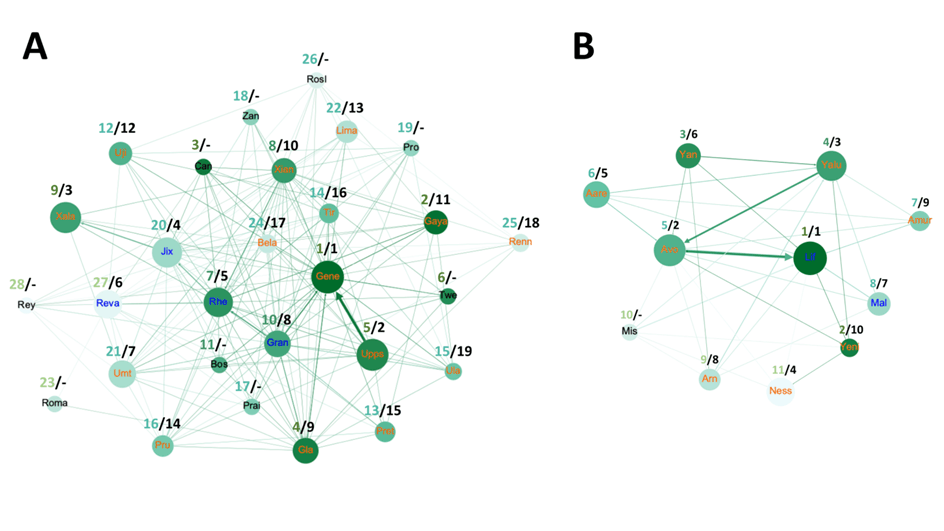

IV. References
Allen, J., Weinrich, M., Hoppitt, W., and Rendell, L. (2013). Network-based diffusion analysis reveals cultural transmission of lobtail feeding in humpback whales. Science. 340, 485-488.
Aplin, L.M., Farine, D.R., Morand-Ferron, J., Cockburn, A., Thornton, A., and Sheldon, B.C. (2015). Experimentally induced innovations lead to persistent culture via conformity in wild birds. Nature 518, 538-541.
Barkow, J.H. (1975). Prestige and culture: a biosocial interpretation. Curr. Anthropol. 16(4), 553-562.
Barrett, B.J., McElreath, R.L., and Perry, S.E. (2017). Pay-off-biased social learning underlies the diffusion of novel extractive foraging traditions in a wild primate. Proc. Biol. Sci. 284, 20170358.
Barrett, B.J. (2019). Equifinality in empirical studies of cultural transmission. Behav. Proc. 161, 129-138.
Bono, A.E.J., Whiten, A., van Schaik, C., Krützen, M., Eichenberger, F., Schnider, A., and van de Waal, E. (2018). Payoff-and sex-biased social learning interact in a wild primate population. Curr. Biol. 28, 2800-2805.
Danchin, E., Nöbel, S., Pocheville, A., Dagaeff, A-C., Demay, L., Alphand, M., Ranty-Roby, S., van Renssen, L., Monier, M., Gazagne, L., Allain, M., & Isabel, G. (2018). Cultural flies: Conformist social learning in fruitflies predicts long-lasting mate-choice traditions. Science. 362, 1025-1030.
Franz, M., and Nunn, C.L. (2009). Network-based diffusion analysis: a new method for detecting social learning. Proc. R. Soc. B. 276, 1829-1836.
Haun, D.B.M., Rekers, Y., & Tomasello, M. (2012). Majority biased transmission in chimpanzees and human children, but not orangutans. Current Biology, 22, 727-731.
Heyes, C.M. (1994). Social-learning in animals: categories and mechanisms. Biol. Rev. biol. P. Camb. 69, 207e231.
Hobaiter, C., Poisot, T., Zuberbühler, K., Hoppitt, W., and Gruber, T. (2014). Social network analysis shows direct evidence for social transmission of tool use in wild chimpanzees. PLos One. 12(9), e1001960.
Hoppitt, W. (2017). The conceptual foundations of network-based diffusion analysis: choosing networks and interpreting results. Phil. Trans. R. Soc. B. 372, 20160418.
Horner, V., Proctor, D., Bonnie, K.E., Whiten, A., & de Waal, F.B. (2010). Prestige affects cultural learning in chimpanzees. PLoS One, 5(5), e10625.
Kendal, R.L., Boogert, N.J., Rendell, L., Laland, K.N., Webster, M., and Jones, P.L. (2018). Social learning strategies: bridge-building between fields. Trends Cogn. Sci. 22, 651-665.
Laland, K. (2004). Social learning strategies. Learning & Behavior. 32(1), 4-14.
Rogers, A. (1988). Does biology constrain culture? American Anthropologist, 90, 819-830.
Vale, G.L., Davis, S.J., van de Waal, E., Schapiro, S.J., Lambeth, S.P., and Whiten, A. (2017). Lack of conformity to new local dietary preferences in migrating captive chimpanzees. Anim. Behav. 124, 135-144.
van de Waal, E., Renevey, N., Favre, C.M., & Bshary, R. (2010). Selective attention to philopatric models causes directed social learning in wild vervet monkeys. Proceedings of the Royal Society B, 277(1691), 2105-2111.
van de Waal, E., Krützen, M., Hula, J., Goudet, J., & Bshary, R. (2012). Similarity in food cleaning techniques within matrilines in wild vervet monkeys. PLoS One, 7(4), e35694.
van de Waal, E., Borgeaud, C., & Whiten, A. (2013). Potent social learning and conformity shape a wild primate’s foraging decisions. Science, 340(6131), 483–485.
van de Waal, E., Bshary, R., & Whiten, A. (2014). Wild vervet monkey infants acquire the food-processing variants of their mothers. Animal Behaviour, 90, 41–45.
Élèves impliqués dans le travail d’écriture (par ordre alphabétique):
AL-KHATIB Khaled, BARRET Lisa, ESTANQUEIRO Charlotte, GLINEL AUBERTEL Elisea, HEIRAULT Leïlou, LAPOINTE Isa, MERMILLOD Léonie, PRIEUR Mathilde, from the DNL Jean Racine high school class, Château-Thierry, and their professor Fanny Bitauld.
*****
Vous pouvez retrouver tous nos articles ici !

